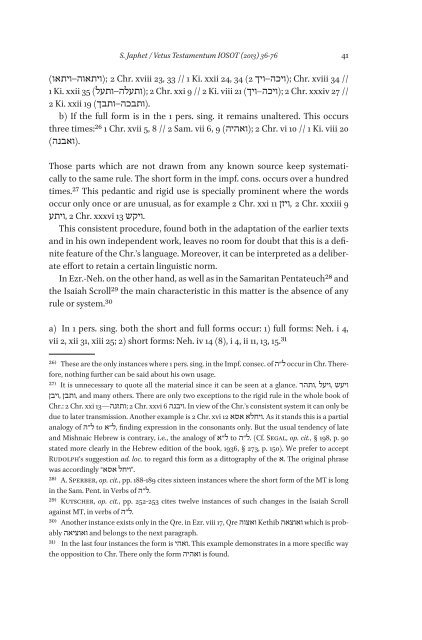Special Issue IOSOT 2013 - Books and Journals
Special Issue IOSOT 2013 - Books and Journals
Special Issue IOSOT 2013 - Books and Journals
Create successful ePaper yourself
Turn your PDF publications into a flip-book with our unique Google optimized e-Paper software.
S. Japhet / Vetus Testamentum <strong>IOSOT</strong> (<strong>2013</strong>) 36-76 41<br />
// 34 Chr. xviii ;)ויכה–ויך (2 34 2 Chr. xviii 23, 33 // 1 Ki. xxii 24, ;)ויתאוה–ויתאו)<br />
1 Ki. xxii 35 ;)ותעלה–ותעל) 2 Chr. xxi 9 // 2 Ki. viii 21 ;)ויכה–ויך) 2 Chr. xxxiv 27 //<br />
.(ותבכה–ותבך( 2 Ki. xxii 19<br />
b) If the full form is in the 1 pers. sing. it remains unaltered. This occurs<br />
three times:26 1 Chr. xvii 5, 8 // 2 Sam. vii 6, 9 ;)ואהיה) 2 Chr. vi 10 // 1 Ki. viii 20<br />
.(ואבנה)<br />
Those parts which are not drawn from any known source keep systematically<br />
to the same rule. The short form in the impf. cons. occurs over a hundred<br />
times.27 This pedantic <strong>and</strong> rigid use is specially prominent where the words<br />
occur only once or are unusual, as for example 2 Chr. ,ויזן xxi 11 2 Chr. xxxiii 9<br />
.ויקש 2 Chr. xxxvi 13 ,ויתע<br />
This consistent procedure, found both in the adaptation of the earlier texts<br />
<strong>and</strong> in his own independent work, leaves no room for doubt that this is a definite<br />
feature of the Chr.’s language. Moreover, it can be interpreted as a deliberate<br />
effort to retain a certain linguistic norm.<br />
In Ezr.-Neh. on the other h<strong>and</strong>, as well as in the Samaritan Pentateuch28 <strong>and</strong><br />
the Isaiah Scroll29 the main characteristic in this matter is the absence of any<br />
rule or system.30<br />
a) In 1 pers. sing. both the short <strong>and</strong> full forms occur: 1) full forms: Neh. i 4,<br />
vii 2, xii 31, xiii 25; 2) short forms: Neh. iv 14 (8), i 4, ii 11, 13, 15.31<br />
26) These are the only instances where 1 pers. sing. in the Impf. consec. of ל״ה occur in Chr. Therefore,<br />
nothing further can be said about his own usage.<br />
ויעש ,ויעל ,ותהר glance. 27) It is unnecessary to quote all the material since it can be seen at a<br />
<strong>and</strong> many others. There are only two exceptions to the rigid rule in the whole book of ,ותבן ,ויבן<br />
Chr.: 2 Chr. xxi ;ותזנה—13 2 Chr. xxvi 6 .ויבנה In view of the Chr.’s consistent system it can only be<br />
due to later transmission. Another example is 2 Chr. אסא xvi 12 .ויחלא As it st<strong>and</strong>s this is a partial<br />
analogy of ל״ה to ,ל״א finding expression in the consonants only. But the usual tendency of late<br />
<strong>and</strong> Mishnaic Hebrew is contrary, i.e., the analogy of ל״א to .ל״ה (Cf. Segal, op. cit., § 198, p. 90<br />
stated more clearly in the Hebrew edition of the book, 1936, § 273, p. 150). We prefer to accept<br />
Rudolph’s suggestion ad. loc. to regard this form as a dittography of the .א The original phrase<br />
.”ויחל אסא“ was accordingly<br />
28) A. Sperber, op. cit., pp. 188-189 cites sixteen instances where the short form of the MT is long<br />
.ל״ה in the Sam. Pent. in Verbs of<br />
29) Kutscher, op. cit., pp. 252-253 cites twelve instances of such changes in the Isaiah Scroll<br />
.ל״ה against MT, in verbs of<br />
30) Another instance exists only in the Qre. in Ezr. viii 17, Qre ואצוה Kethib ואוצאה which is probably<br />
ואוציאה <strong>and</strong> belongs to the next paragraph.<br />
31) In the last four instances the form is .ואהי This example demonstrates in a more specific way<br />
the opposition to Chr. There only the form ואהיה is found.








![Am HaSefer [Volk des Buches] - Books and Journals](https://img.yumpu.com/20648352/1/174x260/am-hasefer-volk-des-buches-books-and-journals.jpg?quality=85)







